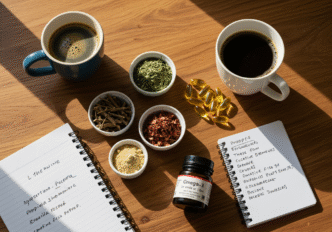

I’ve always found it curious that we’re so fixated on living longer when what really matters is living better. The distinction between lifespan (how long you live) and healthspan (how long you live well) isn’t just semantic—it’s revolutionary in how we approach aging.
Look, I’ll be honest. I turned 47 last month and started noticing things… a bit more knee pain after tennis, needing reading glasses for menus, and yes, those stubborn gray hairs that won’t stay colored for more than two weeks. It got me thinking about what’s actually happening inside my body.
What’s Really Happening in Your Cells When You Age?
So here’s the deal: aging isn’t just wrinkles and forgetting where you put your keys. At a cellular level, it’s like your body’s machinery is slowly wearing down.
One of the most fascinating aspects is telomere shortening. These protective caps on your chromosomes—think of them as the plastic tips on shoelaces—gradually wear away with each cell division. When they get too short, cells either die or become senescent (zombie-like), causing inflammation and tissue damage .
And then there’s the mitochondrial decay. Remember learning about “powerhouses of the cell” in biology class? Well, as we age, these energy factories become increasingly dysfunctional, leading to reduced energy production and increased oxidative stress .
But perhaps the most intriguing piece of this puzzle is NAD+ (nicotinamide adenine dinucleotide), a crucial molecule that declines dramatically with age. NAD+ is involved in hundreds of metabolic processes, including DNA repair and energy production. By age 50, you’ve lost about half the NAD+ you had in your youth. And trust me, your cells feel it .
5 Science-Backed Strategies for Longevity
Wait, this all sounds kind of depressing, right? The good news is that modern science is uncovering ways to actually influence these processes. I’ve spent months researching these interventions, and here’s what’s actually backed by research:
1. Cellular Rejuvenation with NAD+ Boosters
I’ve been fascinated by NAD+ precursors like NMN (nicotinamide mononucleotide) and NR (nicotinamide riboside) ever since David Sinclair’s research hit the mainstream. These compounds help restore declining NAD+ levels, potentially reversing some aspects of cellular aging.
Studies show that boosting NAD+ can improve mitochondrial function, enhance DNA repair mechanisms, and potentially extend healthspan . Some researchers believe it could be one of the most promising approaches to combat aging at the cellular level.
But here’s something people don’t talk about enough—the quality of these supplements varies wildly. After trying three different brands, I noticed significant differences in energy levels and sleep quality. Do your homework before buying!
2. Caloric Restriction & Intermittent Fasting
I used to think intermittent fasting was just another diet fad until I dove into the research. It turns out limiting your eating window triggers a fascinating process called autophagy—essentially your body’s cellular cleanup system.
When you fast for extended periods (typically 16+ hours), your cells start recycling damaged components and clearing out cellular debris. Think of it as your body’s way of taking out the trash and doing some spring cleaning . This process appears to delay multiple aspects of aging and age-related disease.
I’ve been doing 16:8 fasting (eating within an 8-hour window) three days a week for about six months now. The first two weeks were brutal—I won’t sugarcoat it—but now I actually feel more energetic and clear-headed on fasting days. And my annual bloodwork showed improvements in inflammatory markers for the first time in years.
3. Targeted Exercise: Not Just Any Movement Will Do
But wait—you can’t just do any exercise and expect anti-aging benefits. The research points to a specific combination that seems to work best: moderate cardiovascular exercise combined with resistance training.
Cardio improves heart health and blood flow, while strength training preserves muscle mass that naturally declines with age (sarcopenia). Together, they create a powerful synergistic effect on longevity pathways.
The sweet spot appears to be 150 minutes of moderate cardio weekly, plus two strength sessions targeting major muscle groups. And here’s a tip from my personal experience: don’t overlook recovery. At 40+, our bodies need more time to bounce back than they did at 25.
4. High-Quality Sleep: Your Nightly Restoration Process
I spent years thinking I could get by on 5-6 hours of sleep. Big mistake. Sleep isn’t just rest—it’s active cellular repair time.
During deep sleep, your brain clears out toxic proteins like beta-amyloid (associated with Alzheimer’s), growth hormone is released (promoting tissue repair), and memory consolidation occurs. Poor sleep accelerates virtually every hallmark of aging .
Getting consistent, high-quality sleep might be the most underrated anti-aging strategy. After prioritizing 7-8 hours of sleep for the past year, I’ve noticed significant improvements in my skin’s appearance, cognitive performance, and recovery from workouts.
5. Advanced Skin Treatments: Beyond Just Cosmetics
While many think of skin treatments as purely cosmetic, advanced approaches like micro-needling actually trigger biological repair mechanisms that have systemic benefits.
Controlled damage to the skin activates collagen production and stem cell activity. These processes don’t just improve appearance—they reflect deeper cellular rejuvenation pathways that may contribute to overall tissue health and resilience.
After trying micro-needling (which, yes, was uncomfortable but not terrible), I was surprised to find benefits beyond just my skin’s appearance. The improved circulation and cellular regeneration seemed to have more comprehensive effects than I expected.
But Wait… What About This Supplement I Saw Online?
And just a word of caution about the wild world of anti-aging products out there. The global anti-aging market is estimated at a staggering $82 billion as of 2020 . Yet most products have zero scientific backing.
I’ve learned to be extremely skeptical of anything promising “anti-aging miracles.” If it sounds too good to be true, it probably is. The science-backed approaches I’ve outlined above aren’t sexy or instant, but they’re what actually works according to current research.
The Future of Aging: A Revolution in Progress
The most exciting thing about this field is how quickly it’s evolving. Studies on compounds like astaxanthin and rapamycin are showing promising results , and clinical trials for genuine anti-aging interventions are now underway.
We’re living at a fascinating time when the very concept of aging is being redefined. It’s no longer seen as inevitable decline but as a modifiable risk factor . This shift in thinking opens up enormous possibilities for extending not just how long we live, but how well we live during those years.
Frequently Asked Questions
How do I know if NAD+ supplements are working for me?
This is trickier than you might think. Unlike medications for specific conditions, the effects of NAD+ boosters tend to be subtle and cumulative. In my experience, increased mental clarity and energy levels are typically the first noticeable benefits, usually within 2-3 weeks. Some people report improved sleep quality as well. But here’s the catch—you won’t necessarily “feel” the cellular repair happening. Consider baseline testing of inflammatory markers or epigenetic age before starting, then retest after 3-6 months.
Isn’t caloric restriction dangerous for older adults?
Good question—and you’re right to be cautious. Severe caloric restriction can indeed lead to muscle loss and nutritional deficiencies, especially in older adults. That’s why time-restricted eating (maintaining normal caloric intake but within a shorter window) is often a safer approach for many people. Always consult with a healthcare provider before making significant dietary changes, especially if you have existing health conditions or are over 65.
How much exercise is too much when it comes to longevity?
Believe it or not, there is such a thing as too much exercise from a longevity perspective! Excessive endurance training can actually increase oxidative stress and inflammation. The research suggests that moderate exercise (think 30-45 minutes daily) provides most of the longevity benefits without the potential downsides of extreme training. Listen to your body—if you’re constantly fatigued or getting frequent injuries, you might be overtraining.
Can these strategies reverse aging or just slow it down?
This is what everyone wants to know! Current evidence suggests that most interventions can slow aspects of aging and potentially reverse some age-related changes at the cellular level. For example, studies show that certain lifestyle interventions can actually lengthen telomeres and improve mitochondrial function. However, we’re not yet at the point of comprehensive age reversal. The goal right now is to extend healthspan—keeping disease and functional decline at bay for as long as possible.
What’s one simple change I can make today for better aging?
If I had to pick just one thing based on both the research and my personal experience, it would be prioritizing sleep quality. It’s free, requires no special equipment, and impacts virtually every aspect of aging. Start by establishing a consistent sleep schedule (even on weekends), creating a sleep-promoting bedroom environment, and avoiding screens for at least an hour before bed. This simple change can dramatically improve your body’s natural repair processes.
Is it ever too late to start these anti-aging strategies?
The wonderful thing about many of these interventions is that benefits have been observed at virtually any age. Studies have shown improvements in biomarkers even when healthy habits are adopted in the 70s and beyond. While earlier is generally better (preventing damage is easier than repairing it), it’s genuinely never too late to make positive changes. The body has remarkable resilience and adaptive capacity throughout life.
Aging is a complex dance between genetics and lifestyle, but I hope this gives you a useful roadmap for increasing your healthspan. Remember that consistency trumps perfection, and small sustainable changes often yield the greatest long-term benefits.












